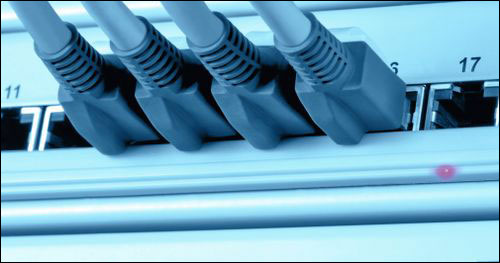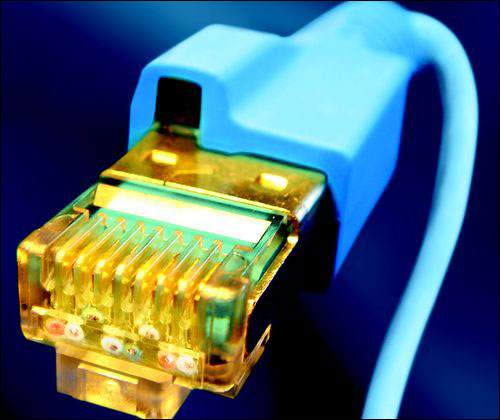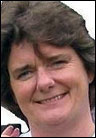The German city of Reutlingen is employing an RFID-based solution known as Future-Patch, provided by TKM, to detect an incorrect or missing patch cable connection, and to then inform users of the correct connection, thereby preventing problems within its IT network. Networks are composed of fiber-optic or copper cables connected to servers, with patch connectors between cables and receiving ports that carry data to a back-end system. If a cable becomes unplugged, or is connected to the wrong port, network performance can be affected, and finding the source of the problem—when there may be tens of thousands of servers and cables involved—can be very time-consuming.
Disconnected cables and ports can occur when computers or other hardware are added to a system, or are moved or switched out. In the event that a connection fails, the consequences can be expensive, since necessary data can no longer be transmitted.

With the Future-Patch solution, a 13.56 MHz passive RFID transponder, compliant with the ISO 15693 standard, is integrated into the plastic casing around each RJ45 copper- cable connector or each LC or ST fiber-optic connector. A Panel Control Unit (PCU) is installed on the panel beneath a row of ports. A single PCU includes a built-in RFID reader and a strip of antennas, with each antenna located beneath a particular port. When a patch cable is brought near a port, its transponder’s unique ID number is interrogated by the adjacent antenna built into the PCU strip. A rack can contain multiple PCUs connected by a bus cable that then carries the read data to a single Rack Control Unit (RCU), installed in that rack. The RCU is connected via an Ethernet cable to a management console linked to the Future-Patch management software on the back-end system.
Each 13.56 MHz transponder—of which TKM uses a variety of models—comes encoded with a unique ID associated in the back-end software system with a specific cable and its specifications, such as the data speeds supported, the bandwidth and the fiber grade (if it is a fiber cable). The user’s infrastructure is designed so that cables with certain specifications may be plugged into particular receiving ports or patch panels, but not others.
If the Future-Patch management software determines that a cable is plugged into the incorrect port connection, the PCU will illuminate an LED light under that port, warning the individual plugging in the cable that a mistake has been made. In addition, when a cable is accidentally unplugged from a port, the software determines that the cable’s tag can no longer be read, and then illuminates the light under that port.
TKM provides its application programmers interface (API) software, which manages read data and can send that data to the user’s own back-end system, or TKM can provide its Future-Patch software platform. A new user first installs the hardware—namely, the PCUs and RCUs. Conventional cables are exchanged with the RFID-enabled cables supplied by TKM, after which the user can employ the Future-Patch software, or its own software, to configure which ports are attached to which PCUs and RCU. Using the Future Patch software, he or she can drag and drop each cable type into the appropriate location on a diagram of the infrastructure, and the software will then store that configuration. The alternative, the company reports, is to enter the correct cable connections into the software first, as a “target state,” and to then install the cables accordingly. Using the software configuration to determine how to install cables in a panel, a user can follow the series of illuminated LED lights on the panel, indicating which port requires a cable.
In the event that changes needs to be made, such as adding or moving some cabled items, the project is first mapped out in the software, to indicate where cables should be plugged into specific ports. As an employee then begins plugging in new equipment, the LEDs of the appropriate PCUs can be illuminated by the software, thereby indicating where each cable should be plugged. If a cable is attached to the proper port, the LED light at that port will cease to be illuminated. If the improper cable is attached, the LED light will flash.
TKM has offered its Future-Patch technology since 2008. At that time, the company first completed its installation at Reutlingen. The city’s Future-Patch deployment, which has since been expanded to a total of 13 floors within three buildings, involves 4,800 Future-Patch RJ45 cables, 220 PCUs and 18 RCUs. There is no technical limit to the number of antennas that can be built into a single PCU, says Doris Eschenbrücher, TKM’s director of marketing, communication and new media. The city of Reutlingen’s deployment includes a PCU with 48 antennas.
The Future-Patch software stores all actions that take place in its “event log,” which can be reviewed by company management. Various users can be configured for access, as well as for receiving notifications.
With the technology in place, Eschenbrücher says, users can be assured that the correct cable and port connections are made, and that they will thus suffer fewer network faults—and, consequently, less down time.



